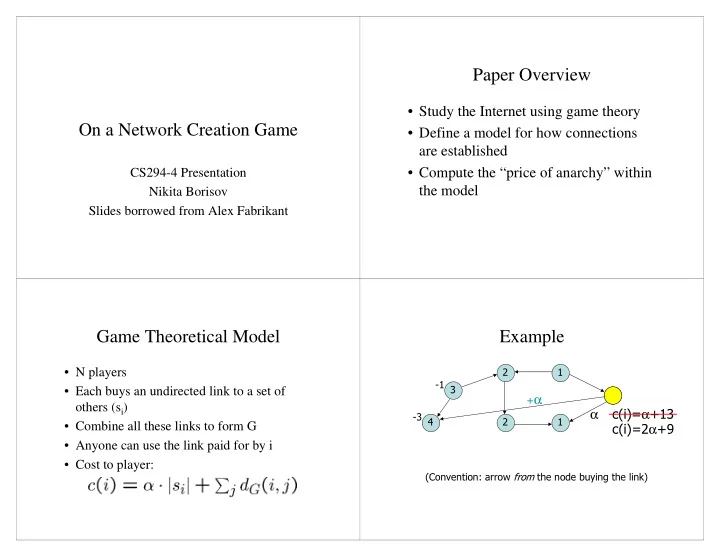

Paper Overview • Study the Internet using game theory On a Network Creation Game • Define a model for how connections are established • Compute the “price of anarchy” within CS294-4 Presentation the model Nikita Borisov Slides borrowed from Alex Fabrikant Game Theoretical Model Example • N players � � �� • Each buys an undirected link to a set of � � α others (s i ) α ����� α ��� �� ������ α �� • Combine all these links to form G � � � • Anyone can use the link paid for by i • Cost to player: ������������������� ����� �������������������������
Model Limitations Social Cost • Each link paid for by single player • Social cost is sum of all the per-player costs c(i) • Disproportionate incentive to keep graph connected • There is an optimal graph G resulting in lowest social cost • Hop count is only metric – Best graph overall – All links cost the same – But not necessarily best for all (or any players) – No handling of congestion, fault-tolerance – Hence, rational players may deviate from • Reaching each node equally as valuable global optimum Nash Equilibrium Price of Anarchy • Nash Equilibrium: no single player can • Ratio between the social cost of a worst- make a unilateral change that will him case Nash equilibrium and the optimum – Rational players will maintain a nash social cost equilibrium • Goal: compute bounds on the price of • Don’t always exist anarchy – They do in this model • Are not always achievable through rational actions
Social optima Nash Equilibria • For α <1, Nash equilibrium is complete • α <2: clique • any missing edge can graph be added at cost α and • For 1< α <2, Nash equilibrium graph has to subtract at least 2 from be of diameter at most 2. social cost �� • α≥ ������� � α • �������������������� • Hence worst equilibrium is a star �������������� General Upper Bound General Upper Bound (cont.) • Assume α >2 (the interesting case) • A counting argument then shows that for every edge present in a Nash equilibrium, • Lemma: if G is a N.E., others are absent – Generalization of the above: • Then: ���� � ��� ������ ������ ������ … � α
Complete Trees Tree Conjecture • A complete k-ary tree of depth d, at α =(d- • Experimentally, all nash equilibria are trees for sufficiently large α 1)n, is a Nash equilibrium • Can’t drop any links (infinite cost increase) • If this is the case, can compute much better upper bound: 5 • Any new edge has to improve distance to each node by (d-1) on average • Proof relies on having a “center node” in graph • Lower bound: price of anarchy approaches 3 for large d,k Discussion Getting back to P2P • Game theory and Nash equilibria important • Is 5 an acceptable price of anarchy? to P2P networks – If not, what can we do about it – Incentive to cooperate • A center node is a terrible topology for the • What about the network model? Internet – In some networks, edges are directed (e.g. Chord) – Extra routing constraint – Incomplete information
Chord Example Discussion? • Assume successor links are free • Is there an α for which Chord is a Nash equilibrium? • Short hops aren’t worth it except for very small α • For large α (>n), defecting and maintaining only a link to your successor is a win
Recommend
More recommend